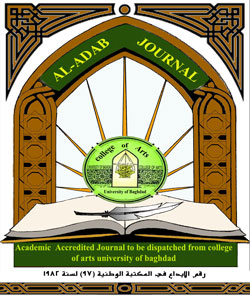Teaching EFL Students Poetic Texts by Applying Pedagogical Stylistics Approach
DOI:
https://doi.org/10.31973/aj.v0i133.868Keywords:
pedagogical stylistics, awareness, stylistic analysis, EFL learningAbstract
It is seen that applying literature in EFL courses and contexts plays an essential role in promoting language skills. Literary stylistic analysis can be used as an effective tool to improve and enhance learner's ability, awareness and, perception in reading and writing. Pedagogical stylistics is a discipline that employs stylistic analysis in teaching written texts to speakers of English as a second language so as to facilitate a better understanding of the meaning of literature and to improve language acquisition.
This study investigates the application of pedagogical stylistics in teaching poetry as a device to improve and enhance students' knowledge of English language learning. Pedagogical activities in the class stimulate students' awareness and competence of how language is structured and used with exposition to the mental processes of comprehension of the meaning. The study aims to answer the following main questions:
1) What is the relationship between style and literature and why literary texts used in language teaching?
2) Is the application of ped+agogical stylistics as a branch of stylistics fruitful and effective in enhancing students' awareness in English language learning?
The study has shown that pedagogical stylistics makes a real contribution to enhance and digest the realization of language learning through literary text. Also, it is revealed that students' intuition, motivation, linguistic and grammatical knowledge are increased with the pedagogical stylistic activities( before, while and after reading) especially when they are given analysis courses of stylistic devices, so they are given more chances and constant encouragement to deepen their performance and skills of learning.
Downloads
References
Abrams etal.,1993. Lccn62. W.W Norton& Company.
New york . London: Longman.
Brumfit, C.J. and Carter, R.A. (eds) (1986). Literature Teaching. Oxford:
Oxford University Press.
Carter, R. (2010). Issues in Pedagogical Stylistics: A Coda .Language
And Literature ,19(1),115-122.DOI:10.1177
Clark, U. (2007). Discourse Stylistics and Detective Fiction: A Case Study.
In Watson& Zyngier (Eds.). Literature and Stylistics for Language
Learners(pp.69-75).Palgrave Macmillan UK.
Cook , G. (2003). Applied Linguistics. Ed. Widdowson, H.G. Oxford:
Oxford University Press.
Gavins, J., & Hodson, J. (2007). When the Students Become the Teachers:
A Practical Pedagogy . In Watson. and Zyngier, S. (Eds) Literature
And Stylistics for Language Learners(p.36).Palgrave Macmillan.
Hall, G. (2005). Literature in Language Education . Basingstoke:
Palgrave Macmillan.
Hall, G. (2014). Pedagogical Stylistics. In Bruke. M. The Rutledge
Handbook of Stylistics(pp.240-252). A Abingdon: Rutledge.
Hess, N. (2003) 'Real Language through poetry: a formula for meaning
making ', ELT journal 51(1) : 19-25.
Lambrou, M. and Stockwell, p. (2007). Contemporary Stylistic. London:
Antony Rowe.
Nada, N. Panel on Why Literature. London: Longman.
Norgaard, N.; Montoro, R. and Busse, B. (2010). Terms in Stylistics. India:
Replika Press Put Ltd.
Sarac, S. (2003). ''A Suggested Syllabus for the Teaching of Poetry Courses
In ELT Department of Turkey'' Unpublished M A Thesis . Ankara:
Hacettepe University.
Simpson, P. (1997) . Language through Literature. London : Routledge.
Widdowson, H . G. (1992) . Practical Stylistics. Oxford: Oxford University press.
Zafeiriadou, N .On Literature in the EFL Classroom in TESOL Greece Newsletter, June 2017, accessed on 9st August 2018: http://www.developingteachers.com/articles_tchtraining/lit1_nelly.htm
Zyngier, S. (2001). Towards a Cultural Approach to Stylistics. Cauce, 24, 365-380. DOI:
https://cvc.cervantes.es/literatura/cauce/pdf/cauce24/cauce24_21.pd
Downloads
Published
Issue
Section
License
Copyright and Licensing:
For all articles published in Al-Adab journal, copyright is retained by the authors. Articles are licensed under an open access Creative Commons CC BY 4.0 license, meaning that anyone may download and read the paper for free. In addition, the article may be reused and quoted provided that the original published version is cited. These conditions allow for maximum use and exposure of the work.
Reproducing Published Material from other Publishers: It is absolutely essential that authors obtain permission to reproduce any published material (figures, schemes, tables or any extract of a text) which does not fall into the public domain, or for which they do not hold the copyright. Permission should be requested by the authors from the copyrightholder (usually the Publisher, please refer to the imprint of the individual publications to identify the copyrightholder).
Permission is required for: Your own works published by other Publishers and for which you did not retain copyright.
Substantial extracts from anyones' works or a series of works.
Use of Tables, Graphs, Charts, Schemes and Artworks if they are unaltered or slightly modified.
Photographs for which you do not hold copyright.
Permission is not required for: Reconstruction of your own table with data already published elsewhere. Please notice that in this case you must cite the source of the data in the form of either "Data from..." or "Adapted from...".
Reasonably short quotes are considered fair use and therefore do not require permission.
Graphs, Charts, Schemes and Artworks that are completely redrawn by the authors and significantly changed beyond recognition do not require permission.
Obtaining Permission
In order to avoid unnecessary delays in the publication process, you should start obtaining permissions as early as possible. If in any doubt about the copyright, apply for permission. Al-Adab Journal cannot publish material from other publications without permission.
The copyright holder may give you instructions on the form of acknowledgement to be followed; otherwise follow the style: "Reproduced with permission from [author], [book/journal title]; published by [publisher], [year].' at the end of the caption of the Table, Figure or Scheme.











